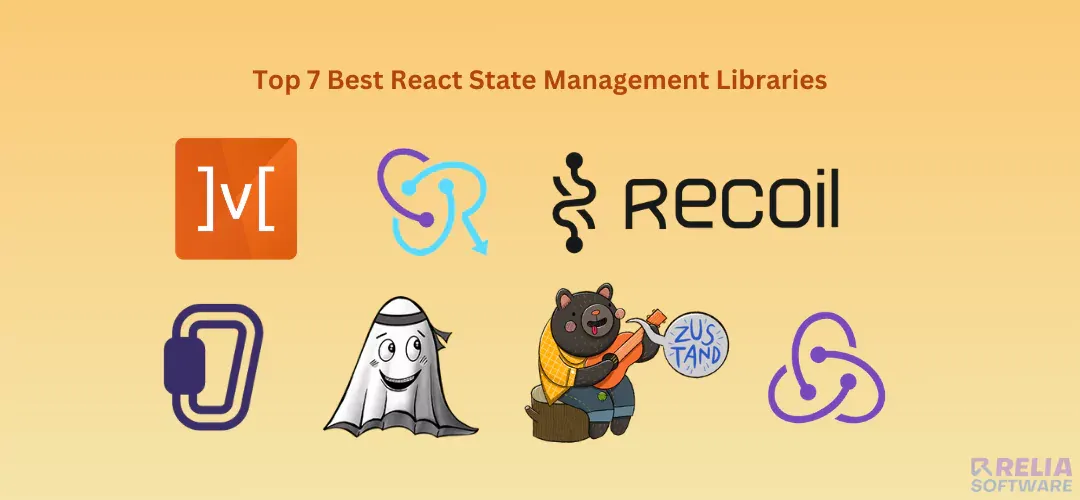Table of Contents
State represents the data that influences your UI's appearance and behavior. As your React applications grow, managing state updates across multiple components can be challenging. This is where React state management libraries come in. These libraries provide tools and patterns to centralize and manage your application's state effectively.
This article will introduce 7 popular React state management libraries, delve into their strengths and weaknesses, and equip you to choose the right tool for your project's needs.
>> Read more about React:
- Top 6 Best React Component Libraries for Your Projects
- Mastering React Higher-Order Components (HOCs)
- The Best React Design Patterns with Code Examples
- Mastering React Test Renderer for Streamlined Testing
What is React State Management?
React state management is the process of managing a React component's state, which determines how the component appears and behaves. The component's current state is represented by the React state, which is subject to change over time because of user input, network requests, or other events. For this reason, having powerful react state management libraries is essential for developing intricate React apps with dynamic user interfaces.
Benefits of Using React State Management Libraries
Here are some typical advantages of using libraries for managing state in React apps:
-
Maintenance: Centralized state storage keeps your code clean and organized, making it easier to understand and maintain. Its maintainability ensures that new members may quickly learn the apps and their current states with little effort of training.
-
Scalability: These libraries are designed to handle complex state requirements, allowing your application to grow seamlessly.
-
Simplified Collaboration: With a single source of truth for state, developers can work on different parts of the application without worrying about conflicting state updates.
-
Predictable Updates: State management libraries enforce clear patterns for state changes, leading to more predictable and bug-free applications.
Overall, state management libraries empower you to build cleaner, more scalable, and more maintainable React applications.
7 Popular React State Management Libraries
Redux
Redux is a predictable state container for JavaScript applications. It enforces a unidirectional data flow architecture, where the whole application state is stored in a single global "store." This approach separates how the state changes (actions) from how it's updated (reducers), simplifying the debugging and testing processes of your app.
State changes are made through actions (plain JavaScript objects) that are dispatched to reducers (pure functions that update the state based on the action). Reducers always create a new state object based on the previous state, promoting immutability and making reasoning about state changes easier.
The biggest issue of Redux is boilerplate code. Specifically, writing actions to describe every state change and multiple reducers to handle them can result in a lot of code that's hard to maintain. Therefore, Redux Toolkit was built to solve that.
For further details, access the official documentation of Redux.
Code Example:
const counterReducer = (state = 0, action) => {
switch (action.type) {
case 'INCREMENT':
return state + 1;
case 'DECREMENT':
return state - 1;
default:
return state;
}
};
const store = createStore(counterReducer);
// Dispatching actions to update state
store.dispatch({ type: 'INCREMENT' });
Recoil
Recoil, a relative newcomer, is a state management library from Facebook based on the Context API. Its aim is to simply implement missing React features like shared state and derived data. It offers atoms (individual state values) and selectors (derived state values based on atoms) for managing application state.
Atoms can be subscribed to by components, allowing them to access and update shared state across the application. Selectors, as pure functions, derive values from atoms or other selectors, and are automatically updated whenever the atoms they depend on change.
Recoil excels in performance and scalability due to its intelligent dependency tracking. It only re-renders components that rely on the specific atom or selector that actually changed. Additionally, its modifiability, maintenance, and integration with React Suspense are also excellent.
However, Recoil has a young React community and ecosystem. Additionally, it is only available in React js.
Click here to access Recoil official documentation.
Code Example:
import { atom, selector } from 'recoil';
const todoListState = atom({
key: 'todoListState',
default: [],
});
const todoListLength = selector({
key: 'todoListLengthState',
get: ({ get }) => get(todoListState).length,
});
function TodoList() {
const [todos, setTodos] = useState(useRecoilValue(todoListState));
const addTodo = (text) => {
setTodos([...todos, { text, completed: false }]);
};
return (
<div>
<button onClick={() => addTodo('New Todo')}>Add Todo</button>
<ul>
{todos.map((todo) => (
<li key={todo.text}>{todo.text}</li>
))}
</ul>
<p>Total Todos: {useRecoilValue(todoListLength)}</p>
</div>
);
}
MobX
MobX is a state management library based on the concept of observable data structures and following the OOP paradigm. It automatically tracks your application state changes and updates components that depend on that state.
MobX promotes immutability, encouraging you to update state by creating new state objects instead of mutating existing ones. This helps prevent unintended side effects in your application.
Unlike some libraries that rely on explicit actions and reducers, MobX offers a more reactive approach. While this can lead to concise and readable code, it might require a slight shift in mindset for developers accustomed to stricter state management patterns.
Click here to access MobX official documentation.
Code Example:
import { observable, action } from 'mobx';
const counterStore = observable({
count: 0,
});
counterStore.increment = action(() => {
counterStore.count++;
});
counterStore.decrement = action(() => {
counterStore.count--;
});
function Counter() {
const { count, increment
Zustand
Zustand offers a lightweight approach to state management for React apps. It offers a simple API (inspired by Context API and hooks) for creating and managing a centralized state store. This store simplifies access and updates from various components.
Zustand leverages React hooks, allowing components to subscribe only to relevant parts of the state and automatically re-render when those parts change. This promotes efficient updates and minimizes unnecessary re-renders, leading to a performant user experience.
Additionally, Zustand allows you to handle asynchronous operations within your store, streamlining data fetching and keeping components in sync. It is ideal for projects that require more than basic state handling but don't necessitate the full complexity of established flux-based libraries.
Click here to access Zustand official documentation.
Code Example:
import create from 'zustand';
const useUserStore = create((set) => ({
user: null,
setUser: (user) => set({ user }),
}));
function App() {
const { user, setUser } = useUserStore();
const login = (username, password) => {
// Simulate authentication logic
setUser({ username, loggedIn: true });
};
return (
<div>
{user ? (
<p>Welcome, {user.username}</p>
) : (
<button onClick={() => login('user', 'password')}>Login</button>
)}
</div>
);
}
Jotai
Jotai is a minimal state management library based on atoms (individual state values). It offers a concise API for creating and accessing atoms throughout your application.
Jotai stands out for its minimal footprint and exceptionally clean API, making it a great choice for projects that prioritize simplicity and performance. It offers a flexible approach to state management with atoms (individual state values). These atoms can be used independently for basic states or combined for more complex scenarios.
Jotai integrates seamlessly with React Suspense and other popular libraries. Additionally, its reliance on JavaScript's garbage collection mechanisms optimizes memory usage and ensures efficient updates.
Click here to access Jotai official documentation.
Code Example:
import { atom, useAtom } from 'jotai';
const counterAtom = atom(0);
function Counter() {
const [count, setCount] = useAtom(counterAtom);
const increment = () => setCount(count + 1);
const decrement = () => setCount(count - 1);
return (
<div>
<p>Count: {count}</p>
Rematch
Rematch is a React state management library that aims to provide a more pragmatic approach compared to complex solutions like Redux. It leverages familiar concepts from Redux (like reducers and actions) but offers a simpler API and a smaller footprint. This makes it a good choice for projects that don't require the full complexity of Redux.
Rematch uses models to organize state, reducers, and effects into a single entity for better organization. Each model represents a specific domain or feature area within your application.
Rematch is written in TypeScript, supports various plugins, and works beyond React (Vue, Angular). These features enhance its usability, performance, and scalability.
Overall, Rematch's ease of learning and clean interface make it an attractive option for developers, especially those new to state management or starting fresh React projects.
Hookstate is a lightweight state management library for React applications. It focuses on a simple approach that leverages React hooks for state management.
Click here to access Rematch official documentation.
Code Example:
import createModel from '@rematch/core';
const initialState = { count: 0 };
export const counterModel = createModel({
reducers: {
increment(state) {
return { count: state.count + 1 };
},
decrement(state) {
return { count: state.count - 1 };
},
},
effects: () => ({
async incrementAsync(payload = 1) {
await new Promise((resolve) => setTimeout(resolve, 1000));
return { type: 'increment', payload };
},
}),
initialState,
});
Hookstate
Hookstate is a lightweight state management library for React applications. It focuses on a simple approach that leverages React hooks for state management.
Hookstate helps define both global state (accessible throughout the application) and local state (specific to a component). It allows partial state updates without the need to recreate the entire state. This promotes efficient updates and minimizes unnecessary re-renders. Hookstate integrates well with React's built-in mechanisms for handling asynchronous operations like promises (async/await).
However, Hookstate doesn't offer the same level of complexity and features as other libraries on this list. It lacks advanced features like selectors, centralized stores, or developer tools found in some established libraries.
Click here to access Hookstate official documentation.
Code Example:
import React, { useState, useCallback } from 'react';
import { useHookstate } from 'hookstate';
const initialState = {
todos: [],
};
const { actions, state } = useHookstate(initialState);
const addTodo = useCallback((text) => {
actions.set({ todos: [...state.get().todos, { text, done: false }] });
}, []);
const toggleTodo = useCallback((index) => {
actions.set({
todos: state
.get()
.todos.map((todo, i) => (i === index ? { ...todo, done: !todo.done } : todo)),
});
}, []);
function App() {
const todos = state.get().todos;
return (
<div className="App">
<h1>To-Do List</h1>
<input type="text" placeholder="Add a to-do" onKeyDown={(event) => {
if (event.key === 'Enter') {
addTodo(event.target.value);
event.target.value = '';
}
}} />
<ul>
{todos.map((todo, index) => (
<li key={index}>
<input type="checkbox" checked={todo.done} onChange={() => toggleTodo(index)} />
{todo.text}
</li>
))}
</ul>
</div>
);
}
export default App;
Here is a comparison table of the aforementioned React State Management Libraries:
|
Library |
Key Features |
Pros |
Cons |
Ideal Use Cases |
|
Redux |
Centralized store, actions, reducers, middleware, time travel. |
|
|
Large applications with complex state management requirements. |
|
Recoil |
Atoms (individual state values), selectors, subscriptions |
|
|
Medium-sized applications with focus on performance and developer experience. |
|
MobX |
Reactive data model, computed properties, observable state. |
|
|
Medium-sized applications with dynamic and interconnected states. |
|
Zustand |
Centralized store, simple API, hooks. |
|
Lacks advanced features like selectors, time travel. |
Small to medium-sized applications with basic to moderate state management needs. |
|
Jotai |
Minimal footprint, atoms, derived atoms. |
|
Lacks features like centralized store, complex state interactions. |
Small-scale applications with simple state management requirements. |
|
Rematch |
Models, reducers, effects, selectors, TypeScript support. |
|
Smaller community compared to Redux, less mature. |
Medium-sized applications seeking a balance between simplicity and features. |
|
Hookstate |
Hooks-based, local and global state, partial updates. |
|
Lacks features like centralized store, selectors, developer tools. |
Small-scale applications or projects with simple state management requirements. |
Key Considerations When Choosing A React State Management Library
Project size and complexity (Small vs. Large projects)
-
Small projects: Consider lightweight solutions like Zustand, Jotai, or Hookstate.
-
Large projects: Explore established libraries like Redux, Recoil, or MobX for complex state management.
Team familiarity and preference
Choose a library your team understands and feels comfortable with for better adoption and maintenance.
Unidirectional data flow vs. Bidirectional data flow
-
Unidirectional data flow (Redux): Predictable state updates, easier to reason about.
-
Bidirectional data flow (MobX): Simpler for complex state interactions, but debugging can be trickier.
Performance considerations
Evaluate the trade-offs between performance and complexity based on your project's requirements. Smaller libraries might offer better performance for simple applications.
Conclusion
Building sophisticated and scalable React apps requires excellent application state management. While React offers built-in mechanisms like Context API for basic data sharing, state management libraries handle complicated state in apps. Various libraries meet different demands, from lightweight Zustand and Jotai to complex Redux and MobX.
The best library relies on project size, complexity, team familiarity, data flow patterns, and performance. By assessing your project's needs and comparing each library's pros and cons, you can choose the best one to manage your application state and streamline development.
>>> Follow and Contact Relia Software for more information!
- coding
- development




